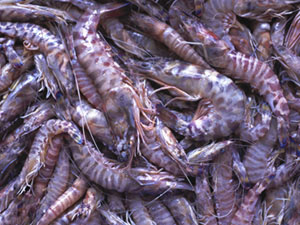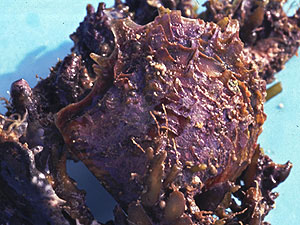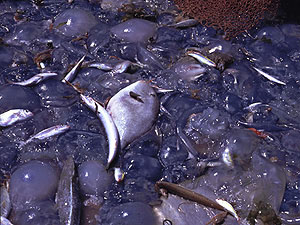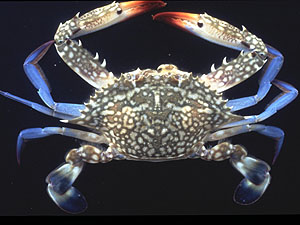Exotics in the Mediterranean - Bioindicators for a sea change
Bella S. Galil
National Institute of Oceanography
POB 8030, Haifa 31080, Israel
Pliny the Elder, the Roman prefect turned naturalist, tells us that "Oyster ponds were first invented by Sergius Orata on the Gulf of Baiae... it was deemed worth while to send to the end of Italy, to Brindisi, for oysters". But it wasn't till the 16th Century that the first transoceanic transplantation have taken place. The so-called "Portugese" oyster,
Crassostrea angulata, was probably transported from Japan by the Portugese. Large-scale transplantations of oysters were initiated only in the 20th Century:
C. angulata was introduced along the French Mediterranean coast, as well as the Tyrrhenian, Ionian, and Adriatic coasts of Italy. The Pacific oyster,
Crassostrea gigas, native to northeastern Asia, was introduced to the Mediterranean coast of France by the late 1960's. A decade after
C. gigas was imported to the Adriatic lagoons of Italy, its larvae were collected off Croatia, and has since been introduced to many Mediterranean locales from Cyprus to Tunisia.
Saccostrea commercialis, a native of coastal New South Wales, was introduced to the Venice Lagoon in the mid -1980's, and was recently found off Turkey. Manila clam,
Ruditapes philippinarum, a native of the western Pacific, was introduced into the lagoons of Languedoc (France) in the late 1970's, to the Venice Lagoon in 1983, and in 1985 to other parts of the Italian coast, including Sardinia.
 |
Erythrean penaeid prawns make up most of the shrimp catches along both Egyptian and Israeli
coasts
Unrestricted transport of commercially important alien oysters have resulted in numerous unintentional introductions of pathogens, parasites and pest species: a comprehensive compilation of marine macrophytes introduced into the Mediterranean by way of oyster farming includes 15 species; 10 are native to Japan. The alga
Sargassum muticum, successfully introduced into the coastal lagoons of Languedoc and northern Spain with
C. gigas, has rapidly covered artificial substrates and negatively affected native algae. Indigenous species are now nearly absent amongst the dense stands of
S. muticum. At Thau lagoon, S. muticum has locally displaced the indigenous
Cystoseira barbata by blocking light and thus inhibiting the recruitment of the native species.
The slipper limpet, Crepidula fornicata, native to the Atlantic coast of North America, was first recorded in the Mediterranean in 1957 from mussel beds near Toulon; it has since arrived in the lagoons of Languedoc. In high densities it may compete with commercial shellfish crop for space and food and may enhance silting. A recent small-scale experimental study shows modification of faunal assemblages resulting from settlement of the limpets.
The small mytilid mussel, Musculista senhousia is native to East Asia. It arrived in the shell-farming lagoons of Languedoc in the 1980's and in the Adriatic. The mussel forms byssal mats on the surface of soft sediments, thus altering native benthic assemblages.
Two parasitic copepods, Mytilicola orientalis and Myicola
ostreae, originally from Japanese waters, have been accidentally introduced with
C. gigas. M. orientalis, an intestinal parasite, and M.
ostreae, a branchial parasite, were recorded from the shell-farming lagoons of Languedoc in 1979. Both species are able to infect the indigenous oyster, Ostrea edulis;
M. orientalis also infects the blue mussel, Mytilus edulis.
Mariculture of nonindigenous shellfish predominates in the northern Mediterranean
lagoonal environments, and those are heavily impacted by exotics, but much of the Mediterranean littoral has its share of exotics. The sea, a hub of shipping, is exceptionally susceptible to ship-borne organisms, whether the non-indigenous species occur in fouling communities or ballast.
 |
Unrestricted transport of commercially important alien oysters have resulted in numerous unintentional introductions of pathogens, parasites and pest
species
The oldest maritime pathway of dispersal and introduction is the transportation of fouling biota, sessile and adherent, on ship hulls. Many cosmopolitan members of the fouling community are quite possibly older introductions into the Mediterranean.
Serpulid worms of the genus Hydroides are frequently found in tropical fouling communities and are among the earliest documented invaders in the Mediterranean:
Hydroides dianthus was documented in Izmir as early as 1865, and collected in Trieste in 1874;
H. dirampha was recorded in Naples in 1870; H. elegans was found, together with
H. dirampha in the Naples harbour fouling community in 1888. Given the state of marine taxonomy in the 19th century, these three Hydroides species may have arrived many years before they were first detected. They are now well established in ports and lagoons throughout the Mediterranean, where they cause major fouling on artificial substrates. These worms are however absent from natural marine habitats.
Of the 61 marine macrophyte species probably introduced into the Mediterranean, 11 came by fouling on ship hulls; 5 of these entries occurred at least half a century ago.
The interoceanic transport of ballast water in ever larger, ever faster vessels has caused a dramatic increase in marine bioinvasions. The American blue crab,
Callinectes sapidus was transported into the Mediterranean in ballast tanks, it was first recorded in the Mediterranean in the 1940's, in Egypt, and successively in Italy, Israel, the Aegean Sea, southern coast of Turkey, the Sea of Marmara, and the Black Sea.
The veined rapa whelk, Rapana venosa, native to the Sea of Japan, was probably introduced into the Black Sea in the 1940's. It was first recorded in 1947 from the oil-exporting port of Novorossiysk; it has since spread to the Aegean, Adriatic and Tyrrhenian Seas. Range extension is probably mediated by ballast transport in early life history stages. In the Black Sea R. venosa has expanded rapidly and decimated the commercially valuable
Mytillus gastroprovincialis.
The opening of the Suez Canal in 1869 initiated the invasion of Erythrean biota into the Mediterranean - hundreds of Erythrean species traversed the canal and settled in the Mediterranean.
 |
The scyphozoan jellyfish, Rhopilema nomadica has proliferated in an astonishingly short span of
time
The scyphozoan jellyfish, Rhopilema nomadica has proliferated in an astonishingly short span of time. This jellyfish was first collected in the Mediterranean in 1977. By the mid - 1980's huge swarms appeared each summer along the southeastern Levant coast. The massive swarms of these voracious planktotrophs, some stretching 40 km, adversely affect fisheries. When drawn nearshore these swarms have blocked water intake pipes of power stations. Swarms of
Rhopilema may have precipitated the population increase of the commercially important carangid fish
Alepes djeddaba, whose juveniles shelter among the jellyfish tentacles.
Other abundant invaders are exploited commercially. A early Erythrean invader, the swimming crab
Portunus pelagicus, was recorded from Port Said in 1898. This crab soon became abundant, and by the early 1900's it was offered in the markets of Port Said, Alexandria and Haifa. Erythrean fish are now nearly half the trawl catch along the Israeli coast, and Erythrean penaeid prawns make up most of the shrimp catches along both Egyptian and Israeli coasts. Growth of some invasive populations to the point that they are harvested commercially is an excellent index of how prevalent they have become.
Though there is no documentation of direct competition between Erythrean and indigenous species, there are many instances of sudden changes in abundance; competition is one explanation. A native penaeid prawn,
Penaeus kerathurus, was commonly caught by trawlers along the Israeli coastal shelf on sandy or sandy mud bottoms, and supported a commercial fishery throughout the 1950's. This native prawn has since nearly disappeared, and its habitat has been overrun by the Erythrean penaeid prawns.
On top of the mariculture, shipping and Eryhtrean introductions, there is hapless chance: a widely invasive tropical alga,
Caulerpa taxifolia, entered the Mediterranean courtesy of the Oceanographic Museum of Monaco. The accidental introduction, with aquaria outflow, probably occurred in 1984. By 1989, it was well established off Monaco, and a year later off Toulon, 150 kms west of its original Mediterranean colony.
C. taxifolia has spread rapidly: in 1991 it was collected near the French-Spanish border; in 1992, in Livorno and Porto Maurizio, and Mallorca; in 1993, off Elba, and Sicily; in 1994, off the Croatian coast, and recently off Tunis.
The Mediterranean strain of C. taxifolia, a robust eurythermic, is able to withstand temperatures as low as 7ºC, and can settle on sand, mud, rock and native seagrass meadows at depths ranging from 2-100 m. Meadows of
C. taxifolia may have up to 14,000 blades per m2. The high growth rate of
C. taxifolia and its exceptionally high densities obliterate the native seagrasses
Posidona oceanica and Cymodocea nodosa.
Native algal communities are drastically altered when invaded by C.
taxifolia. Even encrusting algae disappear, and the associated benthic assemblages show reduced diversity: populations of fishes, amphipod crustaceans, sea-urchins and polychaetes are all deterimentally affected. The toxic secondary metabolites produced by
C. taxifolia inhibit growth of native Mediterranean macroalgae, such as
Cystoseira barbata f. aurantia, and prevent grazing by Mediterranean macro-herbivores, at least during summer and autumn when metabolite-production peaks.
The implacable spread of C. taxifolia threatens the existence of Mediterranean endemics like
Cystoseira spp. Because their bathymetric distribution is restricted to the infralittoral. Wherever
C. taxifolia settles it replaces native seagrass meadows with nearly homogenous, species-poor assemblages.
 |
The American blue crab,
Callinectes sapidus was transported into the Mediterranean in ballast
tanks
Nothing prevents invading species from further travel. The Indo-West Pacific portunid crab
Charybdis hellerii was first sighted in the Mediterranean off the Israeli coast in 1924-1925, and has since been reported off Egypt, Lebanon, Syria, Turkey and Cyprus - a spread common to Erythrean invaders. In 1987
Ch. hellerii was collected in Cuba, and in rapid succession in Venezuela, Colombia, Florida, and Brazil. Transport in ballast tanks is the most probable mode of dispersal because the crab's arrival corresponds to increased shipping contacts with the eastern Mediterranean.
The Chinese mitten crab, Eriocheir sinensis, a native of east Asia arrived in Germany with ballast water by 1912; it has since spread through northern Europe, from Finland to Portugal. The catadromous crab traversed the Garonne canal system and has been repeatedly collected in the Languedoc lagoons.
The American blue crab, transported to the Mediterranean in ballast tanks (see above) is found mainly near harbours, estuaries or lagoons. The catadromous, euryhaline crab is occasionally caught in the Sea of Galilee, a freshwater lake, whence it was accidentally introduced with grey mullet spat collected in the Mediterranean and used to stock the lake.
The pearl oyster, Pinctada radiata was an early Erythrean invader into the Mediterranean. It is now abundant in the Levantine Basin and has spread as far west as the Tyrrhenian Sea, as well as off Sicily and Tunis. Its rapid dispersal may be due to ship-borne individuals, or marine turtles - it was recorded as an epibiont on a loggerhead turtle off Lampedusa Island.
Exotic macrophytes, invertebrates and fish are found in most coastal habitats in the Mediterranean Sea. The Mediterranean Sea has been subjected to introductions of non-indigenous by ship traffic since the opening of interoceanic maritime routes five centuries ago. The Suez Canal has been the largest pathway for the entry of invaders - over 300 Erythrean species have established populations. Nonindigenous shellfish farms serve as gateways into Mediterranean coastal waters for many non-indigenous camp-followers as well. Some invaders have outcompeted or replaced native species locally, severely reducing biodiversity, some other invaders are so abundant they are exploited commercially. The rate of these biotic invasions has increased in recent decades; they collectively have significant ecological and economic impacts in the Mediterranean.
The rapid increase in human population density and urbanization along the Mediterranean shores has brought about coastal development, dredging and landfills, increased levels of agricultural run-offs and industrial wastes. These changes have caused widespread disruption of the littoral ecosystem and decimation of the biota. Low indigenous biodiversity is certainly a factor in determining the numbers of these biotic invasions.
Much of the Mediterranean littoral is no longer a "natural" habitat. In order to track and understand the changes in the Mediterranean littoral biota, both its autochthonous and allochthonous components must be studied, and exotic bioindicators may serve as a practical and widely applicable measure of anthropogenic change.
Additional reading
Ben Tuvia, A., 1973. Man-made changes in the Eastern Medirterranean sea and their effect on the fishery resources.
Marine Biology, 19:197-203.
Boudouresque, C.F., 1994. Les espèces introduites dans les eaux côtières d'Europe et de Méditerrannée: état de la question et conséquences. In:
C. F. Boudouresque, F. Briand, C. Nolan (eds.) Introduced species in European coastal
waters, 8-27. European Commission publ., Luxemburg.
Clanzig, S., 1989. Invertebres d'introduction récente dans les lagunes méditerranéennes du Languedoc-Roussillon (France).
Bulletin de la Société Zoologique de France 114(3): 151-152.
Galil, B.S., 2001. A sea under siege - alien species in the Mediterranean.
Biological invasions 2:177-186.
Ribera, M.A. & C. F. Boudouresque, 1995. Introduced marine plants, with special reference to macroalgae: mechanisms and impact. In:
F.E. Round & D.J. Chapman (eds.) Progress in Phycological
Research, 11: 187-268.
Ruiz, G.M., J.T. Carlton, E.D. Grosholtz, A.H. Hines, 1997. Global invasions of marine and estuarine habitats by non-indigenous species: mechanisms, extent and consequences.
American Zoologist, 37:621-632.
Zibrowius, H., 1992. Ongoing modification of the Mediterranean marine fauna and flora by the establishment of exotic species.
Mésogée, 51: 83-107.
|
